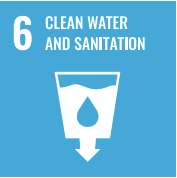Week 5
SDG #6 – Clean Water and Sanitation

Video
In this 10-minute video made available from the SDG Academy, Alejandro Jiménez (Director, Stockholm International Water Institute) looks at SDG #6 – Clean Water and Sanitation. This video discusses inadequate water access, sanitation, and hygiene services as not only related to health issues and protection of the environment but also as a violation of human rights.
Analysis
Water connects the environment with our livelihoods. Improving access to clean water, especially in areas vulnerable to water scarcity, alleviates poverty, improves health and is a precondition for improved quality of life[1]. In July 2010, the United Nations passed a Resolution explicitly recognizing the human right to water and sanitation. The Resolution requires all UN member states to provide financial resources, technology, and capacity to help countries provide safe, clean, accessible, and affordable drinking water and sanitation for all[2].
While substantial progress has been made in increasing access to clean drinking water and sanitation, billions of people, mostly in rural areas, still lack these basic services. Worldwide, 1 in 3 people do not have access to safe drinking water, 2 out of 5 people do not have a basic hand-washing facility with soap and water, and open defecation is a reality for more than 673 million people or 9% of the global population2.
For Canada, access to safe water for drinking and sanitation is increasing, however; access to clean water has yet to be secured for all people in Canada’s population1. Indigenous communities across Canada continue to experience health problems caused by poor water and sanitation, in July 2020, for example, there were 750 boil-water advisories in Canada[3]. First Nations reserves and communities with long-term boil water advisories are faced with the burden of having to boil and/or obtain bottled water for daily use and consumption. This burden is compounded by socio-economic barriers that include poor housing and infrastructure, remoteness, and poverty1.
The COVID-19 pandemic has demonstrated the critical importance of sanitation, hygiene, and adequate access to clean water for preventing and containing diseases. Hand hygiene saves lives. According to the World Health Organization, hand-washing is one of the most effective actions you can take to reduce the spread of pathogens and prevent infections, including the COVID-19 virus. Yet billions of people still lack safe water sanitation, and funding is inadequate.
Fast Facts
- Each day, nearly 1,000 children die due to preventable water and sanitation-related diarrheal diseases;
- Globally, 3 in 10 people lack access to safely managed drinking water services and 6 in 10 people lack access to safely managed sanitation facilities;
- 2.4 billion people lack access to basic sanitation services, such as toilets or latrines with at least 892 million people continue to practice open defecation;
- 1 in 4 health care facilities lacks basic water services;
- Women and girls are responsible for water collection in 80% of households without access to water on premises;
- Water scarcity affects more than 40% of the global population and is projected to rise;
- Over 1.7 billion people are currently living in river basins where water use exceeds recharge;
- Worldwide, more than 80% of wastewater resulting from human activities is discharged into rivers or sea without any pollution removal;
- Approximately 70% of all water abstracted from rivers, lakes and aquifers is used for irrigation;
- Floods and other water-related disasters account for 70% of all deaths related to natural disasters.
Why it Matters
Why should I care about clean water and sanitation? Millions of people die every year, including millions of children, from water-related diseases such as malaria and diarrhoea. Water is essential not only to health, but also to poverty reduction, food security, peace and human rights, ecosystems, and education. The lack of clean water and proper sanitation under¬mines prosperity and efforts towards a more sustainable future.
Targets and Indicators for Canada
Below is Canada’s approach to measuring progress on SDG #6 – Clean Water and Sanitation. Note the targets and indicators chosen[4].

Recommended Reading
- United Nations. (2021). The Sustainable Development Goal Report, 2020. Ensure availability and sustainable management of water and sanitation for all.
- Global Affairs Canada. (2018). Canada’s Implementation of the 2030 Agenda for Sustainable Development: voluntary national review. ↵
- United Nations. (2021). Sustainable Development Goals. ↵
- University Affairs. (2021). Canada’s troubled waters. ↵
- Statistics Canada. (2021). The Canadian Indicator Framework for the Sustainable Development Goals - 2021. ↵

